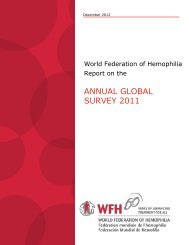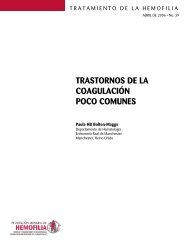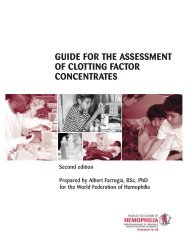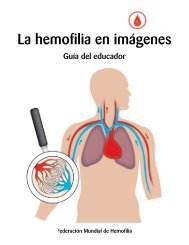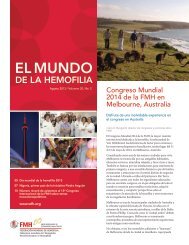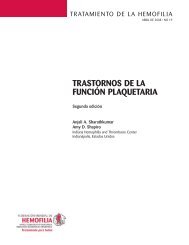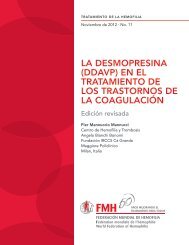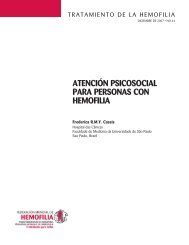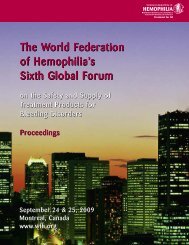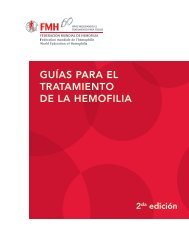musculoskeletal complications of hemophilia: the joint
musculoskeletal complications of hemophilia: the joint
musculoskeletal complications of hemophilia: the joint
Create successful ePaper yourself
Turn your PDF publications into a flip-book with our unique Google optimized e-Paper software.
Aspiration may be useful initially to control <strong>the</strong> swelling with <strong>the</strong> <strong>joint</strong> and should be<br />
undertaken after prophylaxis has been started but before steroids are used. Immobilization is<br />
useful at times but must be used in conjunction with physical <strong>the</strong>rapy to prevent atrophy and<br />
loss <strong>of</strong> range <strong>of</strong> motion.<br />
A lack <strong>of</strong> response <strong>of</strong> <strong>the</strong> recurrent bleeding <strong>of</strong> synovitis after three to six months <strong>of</strong><br />
prophylaxis and treatment is usually considered an indication for more aggressive<br />
intervention. Open surgical synovectomy, arthroscopic synovectomy and radioactive<br />
synovectomy should <strong>the</strong>n be considered. The indications and management <strong>of</strong> <strong>the</strong>se procedures<br />
will be considered in a later monograph.<br />
The Arthritic Joint (Hemophilic Arthropathy)<br />
Despite early and what seems to be adequate treatment, <strong>the</strong> progression <strong>of</strong> bleeding and<br />
synovitis to arthropathy have not been eliminated. Only prophylactic replacement <strong>of</strong> <strong>the</strong><br />
missing clotting factor started soon after <strong>the</strong> first bleeding episode holds promise <strong>of</strong> doing<br />
this, but it is not economically or medically feasible in most parts <strong>of</strong> <strong>the</strong> world. To minimize<br />
<strong>the</strong> consequences <strong>of</strong> an hemarthrosis which has not responded or cannot be adequately treated<br />
with factor replacement, short-term immobilization should be considered. This can lead to<br />
fur<strong>the</strong>r deformity. Isometric exercises should be started immediately and should quickly<br />
progress to more vigorous streng<strong>the</strong>ning exercises and range <strong>of</strong> motion exercises.<br />
For recalcitrant <strong>joint</strong>s, <strong>the</strong> temporary use <strong>of</strong> braces and splints have proven beneficial. A<br />
prefabricated sports brace can be useful. They usually have a hinge that can be locked and<br />
opened to allowed progressive motion, especially at <strong>the</strong> knee. A molded ankle-foot orthosis<br />
will frequently control pain and bleeding at <strong>the</strong> ankle. High shoes and orthoses can be<br />
inexpensive and have been used to minimize foot and ankle problems. Temporary splinting<br />
may be used to control pain and bleeding at <strong>the</strong> elbow, but long-term use is not feasible as it<br />
interferes with function. Again I must stress that physical <strong>the</strong>rapy must be used in conjunction<br />
with all forms <strong>of</strong> splinting.<br />
If a flexion contracture has developed at <strong>the</strong> knee, cast correction is indicated. Serial casting,<br />
wedge casting and <strong>the</strong> use <strong>of</strong> desubluxation-type hinges have been successful in correcting<br />
<strong>the</strong>se contractures. Serial casting can be used on an outpatient basis. Wedge casting works<br />
more quickly but usually requires that <strong>the</strong> patient be admitted to <strong>the</strong> hospital. A desubluxation<br />
hinge is used if <strong>the</strong>re is any evidence <strong>of</strong> posterior subluxation or if <strong>the</strong> contracture is greater<br />
than 45º. Following correction, <strong>the</strong> patient is kept in a brace until physical <strong>the</strong>rapy has<br />
streng<strong>the</strong>ned <strong>the</strong> muscles around <strong>the</strong> knee, especially <strong>the</strong> quadriceps. This usually takes three<br />
to six months.<br />
5



